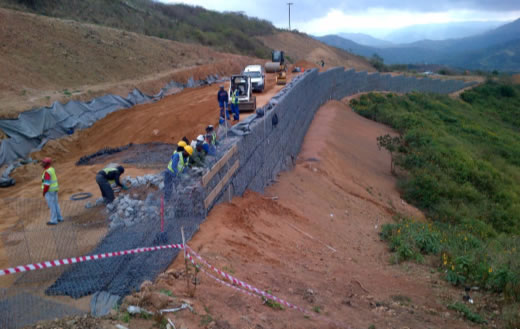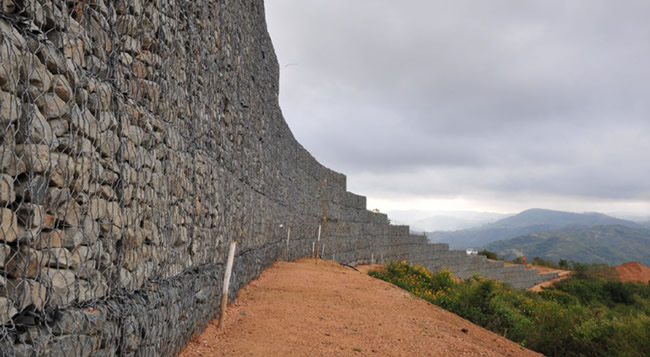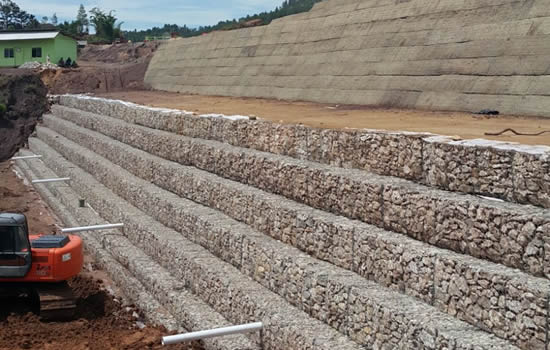By Maccaferri – When the improvement works to the main road P728 in the Umgababa area were approved by the eThekwini Municipality, KwaZulu-Natal Province, South Africa, a mechanically stabilized earth (MSE) wall was needed to complete the project. Maccaferri designed and supplied a 270m-long, 9m-high reinforced soil structure using the Terramesh® System reinforced with ParaGrid® primary geogrid. This reinforced soil structure supports the highway’s improvement through hilly terrain with a surcharge load of 12kN/m².
The solution proved to be easy to install and cost-effective. Also, the works created numerous local jobs, as much of the construction was able to be carried out with general labor.

A REINFORCED SOIL STRUCTURE IMPROVES RURAL ACCESS
The rural coastal community of Umgababa, located south of Durban, has become increasingly popular for tourism. To support further economic activity, the eThekwini Municipality decided to upgrade the main road P728.
Simani Consulting headed up the project engineering, which involved finding the best solution for constructing a large retaining wall in the hilly terrain. The consultant brought in Maccaferri to provide design, supply, and construction support for the reinforced soil structure. Although the ground to be retained was of good quality and there were no phreatic surfaces within the vicinity of the wall, the presence of slopes above and at the foot of the wall placed an emphasis on the overall stability of the structure. Loads of 12kN/m² needed to be considered as the highway live load on top of the structure.
RELATED: Runways and Reinforced Structures for Tana Toraja
Maccaferri proposed a Terramesh® System from 3m to 9m high, founded to depths of up to 2m. Terramesh® consists of a modular gabion fascia element, with an integral steel wire woven mesh geogrid tail. The geogrid is sandwiched between layers of compacted structural backfill, reinforcing it. This enables the soils to stand steeper, accommodate greater loads, and settle less than an unreinforced soil.

On the taller reinforced soil structure and where the geotechnical forces are far greater, the Terramesh® units were reinforced using Maccaferri’s unique geogrid ParaGrid®.
What makes this geogrid unique are the planar structures consisting of a biaxial array of composite geosynthetic strips. The strips comprise of a core of high tenacity polyester tendons encased in a polyethylene sheath. They have been used internationally and offer 120-year design lives. The tough polyethylene sheath is resistant to physical, chemical, and biological conditions found commonly in a reinforced soil structure.
Additionally, the engineering solution was aided by the use of a proprietary MSE wall software program, MacSTARS.
RELATED: Geosynthetic Design Software and Calculator Tools
REINFORCED SOIL STRUCTURE BENEFITS
In addition to meeting technical performance goals for the project, the geosynthetic reinforced soil structure solution offered numerous benefits:
- Easy transportation to and storage on the site, which had some logistical challenges for construction access.
- Easy installation, which enabled general labor (and, thereby, supported the South African government strategy of job creation within the Expanded Public Works Programme (EPWP)).
- Cost effective: the Terramesh® design required significantly less rock fill than other solutions, including gabions.
- The primary geogrid can be used with most types of backfills, including marginal fills. This often enables the reuse of site-won materials as structural backfill, which reduces the amount of imported materials, saving project cost and time.
- The flexible structure is able to withstand the loads and vibrations that may be present during and after construction of the road.

For more information, visit www.maccaferri.com. A copy of the this case study, with addition information, is also available for PDF download.
**
SEE ALSO:
Maccaferri Geosynthetics Industry Profile











